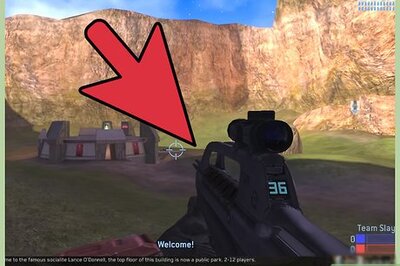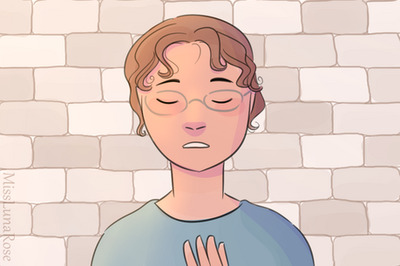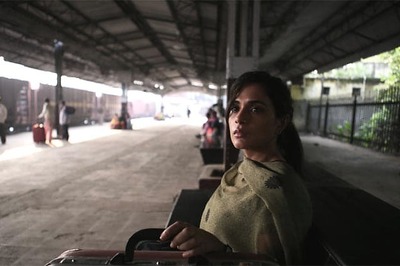
views
"The seas may roll between us; you are still in our memory dear"- Mum, Dad, Bill.
Engraved on Lance Corporal GS Mead's tombstone at Kohima War
Cemetery.
Mead at 22 was perhaps no different from others of his age, he had a family who loved him and cherished dreams for his future. But those were the times of war, which made soldiers out of men and Corporal Mead fell fighting the Battle of Kohima, one of the bloodiest battles of the Second World War. Mead and his fellows had stalled the Japanese advance into India and changed the course of the Second World War paying the highest possible price, their lives.
In the heart of Kohima town in Nagaland the Kohima War Cemetery is one of the most touching tributes to the Second World War heroes and one of the few where soldiers are buried on the very spot where they had died.
"The cemetery which you see today was built on the actual battleground" said Atuo Mezhur, regional manager of the Commonwealth War Graves Commission, which maintains Second World War graves across the globe.
"The small hill on which the graves rest once had the Chief Commissioners Bungalow and it was here on 4th April 1944 that the British Second Division engaged the Japanese 31st division of over 10,000 men in a hand to hand combat, pitched against each other within 50 meters or less" he told me.
"The Japanese however failed to take the hill and it was the beginning of the Japanese retreat in the World War. They left their dead and dying when pursued by Allied troops, said Mezhur. The cemetery also has graves of men from the Kohima Garrison; a force of a mere 800 men who kept on fighting for their lives and honour and held the Japanese advance for 13 long days, till a larger British force relieved them, allowing a few of them to live and narrate their chilling saga.
The tumultuous history of the Battle of Kohima is engraved over the tombstones. The script on each stone sheds a different light on the circumstances that prevailed. "Among the 1421 soldiers buried here, the cemetery has two Victoria Cross winners" said Mezhur pointing to the graves of Captain John Randall and Lance Corporal JP Harmon "both these men played decisive roles in stalling the enemy's advance he said. While Harmon led a
forward platoon against a Japanese machine gun post, single-handedly killing several enemy soldiers before he succumbed to injuries, John Randall had after destroying an enemy post flung himself over a live bomb to save others of his unit.
Since the end of the war the War Cemetery has received visitors from all over the world, war veterans, relatives of soldiers and many others keen on having a glimpse of the battle saga, said a caretaker. His words were echoed in the visitor's book, "After 60 years I feel united with my brother" an entry by Ian Trigger from Wales read.
Emotions are equally strong over the other side. Every year we get as many Japanese visitors as others" said Atuo Mezhur, and added The Japanese lost over 8,000 men, much more than the British, almost the entire Japanese 31st Division was wiped out in one single battle in Kohima. There were prayer ceremonies held by Japanese visitors in the Cemetery. The post war years saw attempts of reconciliation and amendments.
The Japanese government helped build Kohima Catholic Church, now a major tourist attraction for its architecture and vast interiors of tinted glass said Nagaland government authorities. With time the pain has subsided for most but the memories of those who fought for the defence of their homeland remains strong as ever.
Alongside the British are graves of Indian soldiers. The cemetery divided into Christian, Hindu, Muslim and Jewish sections has familiar sounding names like Mojis Jadhav of the Royal Indian regiment, Harka Man Limbu of the 7th Gurkha Rifles and Captain Ajit Kumar Basu of the Indian Army Medical Corps and many like them who
fought and died along with their British counterparts.
Situated atop a hill overlooking the picturesque Kohima township, the War cemetery now affords a place of peaceful rest and serene recollection. The lush green hill with its neat brass-plated
tombstones is a mute testimony of the fury and pain of war.first published:March 29, 2006, 15:13 ISTlast updated:March 29, 2006, 15:13 IST
window._taboola = window._taboola || [];_taboola.push({mode: 'thumbnails-mid-article',container: 'taboola-mid-article-thumbnails',placement: 'Mid Article Thumbnails',target_type: 'mix'});
let eventFire = false;
window.addEventListener('scroll', () => {
if (window.taboolaInt && !eventFire) {
setTimeout(() => {
ga('send', 'event', 'Mid Article Thumbnails', 'PV');
ga('set', 'dimension22', "Taboola Yes");
}, 4000);
eventFire = true;
}
});
window._taboola = window._taboola || [];_taboola.push({mode: 'thumbnails-a', container: 'taboola-below-article-thumbnails', placement: 'Below Article Thumbnails', target_type: 'mix' });Latest News
Death is a powerful equalizer. Kohima war cemetery is one of the most powerful reminders of this fact as you wander among graves thinking of men who died fighting each other in an alien land.....
"The seas may roll between us; you are still in our memory dear"- Mum, Dad, Bill.
Engraved on Lance Corporal GS Mead's tombstone at Kohima War
Cemetery.
Mead at 22 was perhaps no different from others of his age, he had a family who loved him and cherished dreams for his future. But those were the times of war, which made soldiers out of men and Corporal Mead fell fighting the Battle of Kohima, one of the bloodiest battles of the Second World War. Mead and his fellows had stalled the Japanese advance into India and changed the course of the Second World War paying the highest possible price, their lives.
In the heart of Kohima town in Nagaland the Kohima War Cemetery is one of the most touching tributes to the Second World War heroes and one of the few where soldiers are buried on the very spot where they had died.
"The cemetery which you see today was built on the actual battleground" said Atuo Mezhur, regional manager of the Commonwealth War Graves Commission, which maintains Second World War graves across the globe.
"The small hill on which the graves rest once had the Chief Commissioners Bungalow and it was here on 4th April 1944 that the British Second Division engaged the Japanese 31st division of over 10,000 men in a hand to hand combat, pitched against each other within 50 meters or less" he told me.
"The Japanese however failed to take the hill and it was the beginning of the Japanese retreat in the World War. They left their dead and dying when pursued by Allied troops, said Mezhur. The cemetery also has graves of men from the Kohima Garrison; a force of a mere 800 men who kept on fighting for their lives and honour and held the Japanese advance for 13 long days, till a larger British force relieved them, allowing a few of them to live and narrate their chilling saga.
The tumultuous history of the Battle of Kohima is engraved over the tombstones. The script on each stone sheds a different light on the circumstances that prevailed. "Among the 1421 soldiers buried here, the cemetery has two Victoria Cross winners" said Mezhur pointing to the graves of Captain John Randall and Lance Corporal JP Harmon "both these men played decisive roles in stalling the enemy's advance he said. While Harmon led a
forward platoon against a Japanese machine gun post, single-handedly killing several enemy soldiers before he succumbed to injuries, John Randall had after destroying an enemy post flung himself over a live bomb to save others of his unit.
Since the end of the war the War Cemetery has received visitors from all over the world, war veterans, relatives of soldiers and many others keen on having a glimpse of the battle saga, said a caretaker. His words were echoed in the visitor's book, "After 60 years I feel united with my brother" an entry by Ian Trigger from Wales read.
Emotions are equally strong over the other side. Every year we get as many Japanese visitors as others" said Atuo Mezhur, and added The Japanese lost over 8,000 men, much more than the British, almost the entire Japanese 31st Division was wiped out in one single battle in Kohima. There were prayer ceremonies held by Japanese visitors in the Cemetery. The post war years saw attempts of reconciliation and amendments.
The Japanese government helped build Kohima Catholic Church, now a major tourist attraction for its architecture and vast interiors of tinted glass said Nagaland government authorities. With time the pain has subsided for most but the memories of those who fought for the defence of their homeland remains strong as ever.
Alongside the British are graves of Indian soldiers. The cemetery divided into Christian, Hindu, Muslim and Jewish sections has familiar sounding names like Mojis Jadhav of the Royal Indian regiment, Harka Man Limbu of the 7th Gurkha Rifles and Captain Ajit Kumar Basu of the Indian Army Medical Corps and many like them who
fought and died along with their British counterparts.
Situated atop a hill overlooking the picturesque Kohima township, the War cemetery now affords a place of peaceful rest and serene recollection. The lush green hill with its neat brass-plated
tombstones is a mute testimony of the fury and pain of war.




















Comments
0 comment